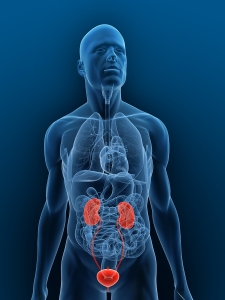In the urinary tract yeast infection of bladder and kidneys is, as the name implies mainly affecting the bladder or the kidneys.
Patients who are diabetic, cancer patients or patients who are immunocompromised (AIDS, chemotherapy for leukemia, immunosuppressive drugs for transplanted organs) are more susceptible for yeast infections of the urinary tract.
1. Yeast infection of the bladder
In the bladder Candida infections are usually due to manipulation with Foley catheters that are given in hospitals for procedures, during periods of unconsciousness in the Emergency Department or during labor and delivery. Also antibiotic therapy to treat bacterial infection of the bladder will often be followed by yeast infections.
Symptoms
The patient usually experiences frequent and painful urination with small amounts of urine each time, urgency and possibly pain in the center of the lower abdomen. A urinary culture will often lead to the diagnosis.
Treatment
Fluconazole at a dosage of 150 mg to 200 mg daily is given for a period of time(1 to 4 weeks). However, there can be liver toxicity and other toxic side-effects and the physician has to balance this in relation to the benefit of the treatment.
2. Yeast infection of the kidneys
Yeast infections of the kidneys originate usually from spread by the blood stream. Any yeast bugs that would have originated from the gut will be transported by the blood into the kidneys and as the kidneys filter the blood, will infect the kidney tissue. Again, patients with immune deficiencies as mentioned above are affected more seriously and more commonly. Also, patients who have indwelling catheters in their veins or arteries are particularly at risk for yeast infections of the kidneys as a yeast infection from the tips of such devices can spread via the blood stream to both kidneys.
Symptoms
It can be very difficult for the physician to diagnose blood born yeast infection of the kidneys as the only symptom might be a fever resistant to antibiotic therapy. Blood tests would show a deteriorating renal function and a midstream urine culture would grow Candida albicans. Sometimes fungus balls develop in the origin of the ureter and as they migrate further down this may lead to an obstruction with renal colic like pains. Associated with this would be blood in the urine. If treatment is not given swiftly or the diagnosis not recognized, the yeast infection will spread through the blood stream into other organs such as the liver, the spleen, the brain, the eyes and the skin. It can also lead to septicemia and shock.
Treatment
Yeast in urine (candiduria) is best treated with fluconazole (brand name: Diflucan) for 1 to 2 weeks. However, if the specialist( usually the urologist or nephrologist) has determined that the yeast infection is established in the kidney tissue, then a higher dose and longer treatment schedule is needed to eradicate the yeast infection from the kidneys. In the first few days a course of intravenous amphotericin B might have to be given. Subsequently the patient can then be switched to oral fluconazole of 400 mg or higher per day until the infection has cleared. In these life threatening situations higher than usual doses of the antifungal have to be given.
References:
1.The Merck Manual, 7th edition, by M. H. Beer s et al., Whitehouse Station, N.J., 1999. Chapter 158.
2.The Merck Manual, 7th edition, by M. H. Beers et al., Whitehouse Station, N.J., 1999. Chapter 113.
3. The Merck Manual, 7th edition, by M. H. Beers et al., Whitehouse Station, N.J., 1999. Chapter 164.
4.David Heymann, MD, Editor: Control of Communicable Diseases Manual, 18th Edition, 2004, American Public Health Association.







